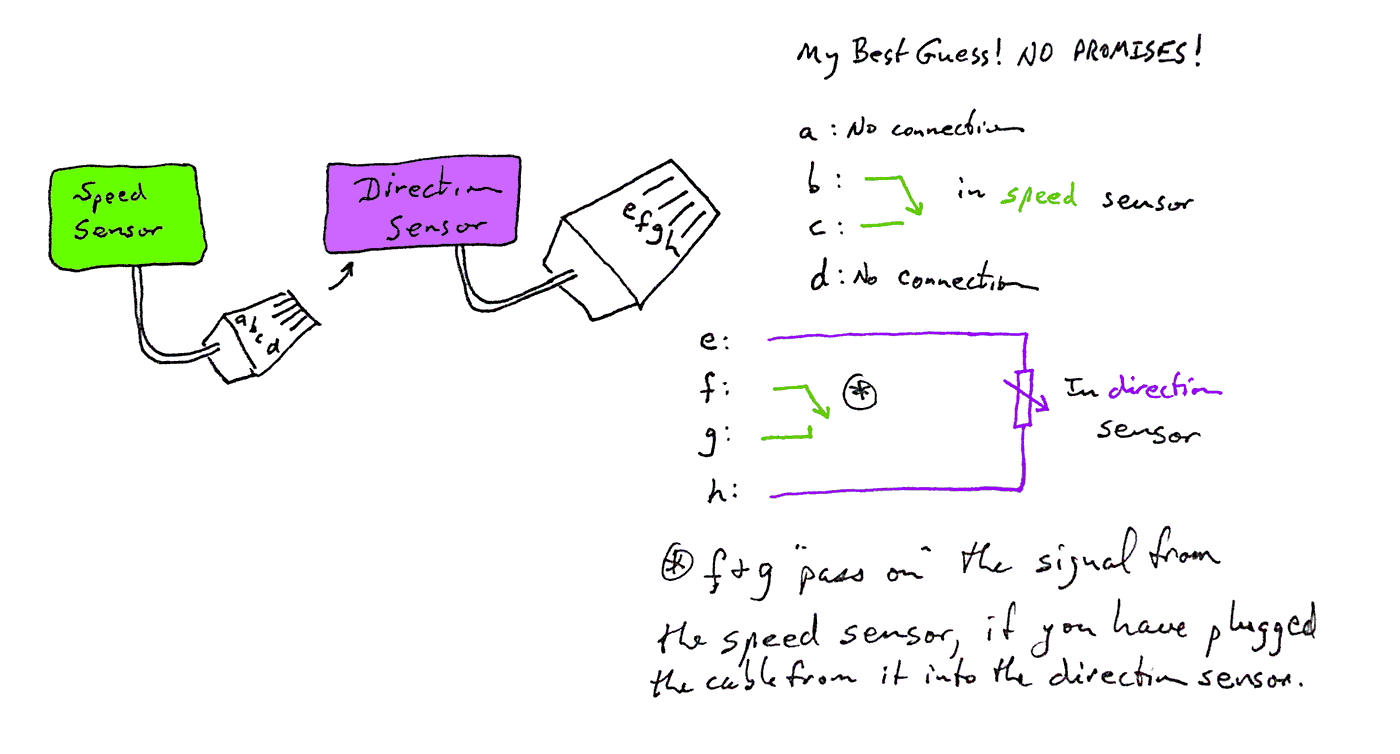
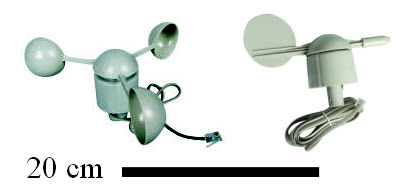
It seems a long time I've been looking for wind speed or direction sensors, of a simple design, at a good price for the hobbyist. I want to connect them up to an Arduino, but they could be connected to a Pi, BBC: Micro Bit or lots of other things. There's a lot of fun in "making your own"... but if you can get the sensors made up for you, there's still lots for you to make, in the things connected to them. They are WELL worth the money. Trust me. Make your own? Been there... done that... don't want to do it again!
(If you want to connect either or both of these to a "big" computer (Apple, Linux, Windoze), you might want to do it through one of the little computers mentioned above. The little computer could turn the output from the sensors in a stream of serial data, acting, as it were, as a "pre-processor".)
In April, 2016, I obtained (mail order) some nice sensors from the UK electronics store "Maplin". Three windspeed sensors, with p&p came to about $15. One of the direction sensors, with p&p, about $10. Part codes: N82NF and N81NF, respectively.
Maplin only sells them for use with their weather stations (N96FY and N96GY), but both seem eminently hackable. The point of this page is to save you 15 minutes with a meter.
The two sensors mentioned here are often sold as part of a "set" of sensors... speed, direction, rainfall. But, as at Maplin, sometimes you can find individual units for sale on their own.
In the US, I have seen what looks to be the same sensors sold as part of "complete sets". These are nice, if you want to go that route. Besides the wind speed and direction sensors, you also get a rainfall measuring device, and "arms" to mount everything on. (The provision on the wind sensors for attachment to the "arms" is good... and easily adapted to other mounting choices.
At 1/17, what seems to be the same sensors, as parts of a complete kit were available from Argent ($68 plus p &p at 1/17) and Sparkfun ($77 plus p &p at 1/17) also sells what, I think, Argent created. Both sites have useful technical detail, to tell you things that I've missed or not explained successfully. Sparkfun, at 1/17, has been my main "go to" for Good Stuff for some time. They give good documentation, ship quickly, are reliable. I pay a slight premium, yes... and it is worth it. (I do tend to buy simple components, e.g. sockets for ICs from "the cheap" alternatives... and sometimes "pay" in other ways for my parsimony.) Argent has been selling the device since at least August 2011.. and they haven't raised the price since then, either! (Argent lists both the anemometer and rain gauge separately, as "replacement parts". Ask them nicely, and who knows... they might sell the wind direction sensor separately, too.)
The speed sensor has a reed relay in it... you can hear it click. In early investigations, I thought, from listening to "clicks", that it opens and closes once for each full rotation of the three cups which catch the wind. Later, more thorough investigations turned up two interesting points...
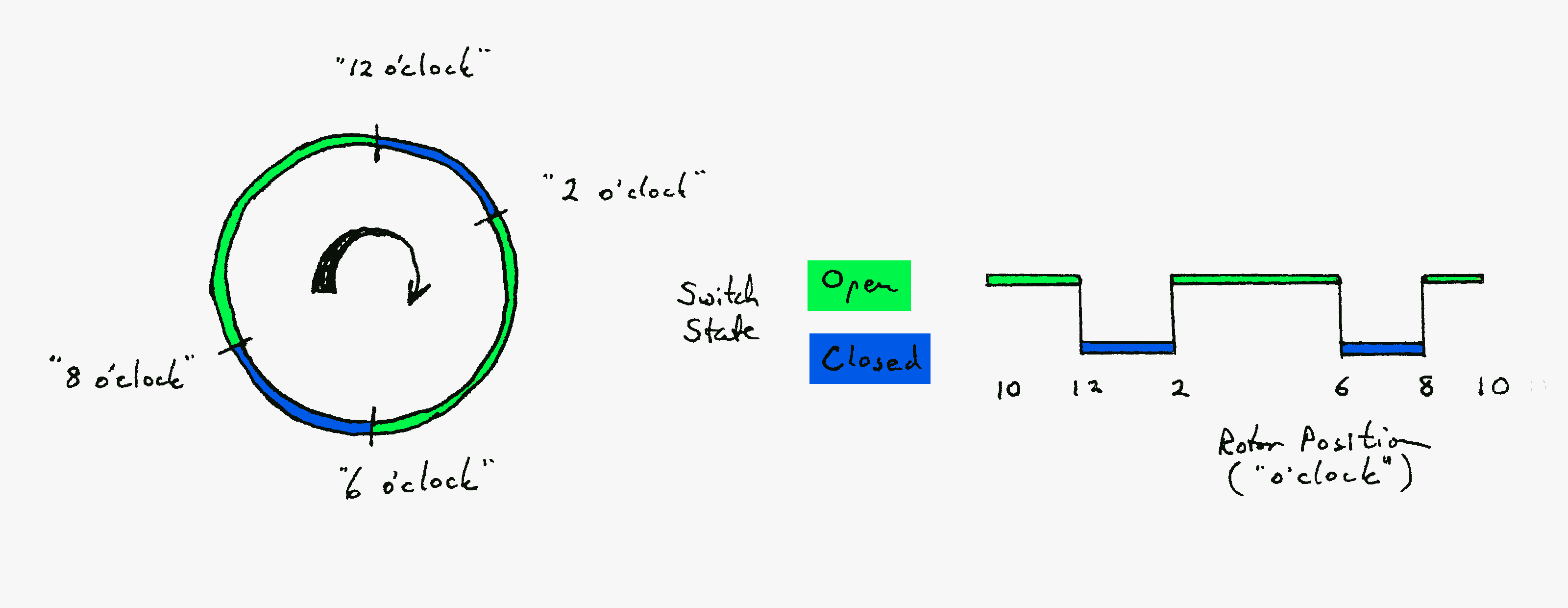
First: The switch opens and closes TWICE for one revolution of the cups, doubling the resolution of the sensor. That's four "edges" to detect, if your counter detects both rising and falling edges.
But what really impressed me is the fact that the "open" time and the "closed" times are nearly equal. This is a big help to any system that has somewhat crude electronics/software, which merely poll the state of the line from time to time. Some of my home-made sensors, while they have "worked", have switches which are only closed briefly. Without better-than-crude electronics/ software to monitor the state of the switch, some "closed" moments would be missed.
The documentation bravely declares: "A wind speed of 1.492 MPH (2.4 km/h) causes the switch to close once per second." I suspect that this was true on the unit tested... but also that there is variation in that "constant" from one speed sensor to another, and from one month to another even in the case if a single sensor. I still believe that it is capable of collecting interesting records for you. If you have access to a portable, sophisticated wind speed sensor... they exist!... you might want to record your system's RPM at different wind-speeds once in a while, to enhance the usefulness of your records.
(Are winds in your neighborhood getting stronger over time? (Global warming?.. winding??) Or is it just that the bearings in your anemometer are becoming smoother with usage?)
The direction sensor is a LITTLE more "complex". Two wires come from it. A resistance exists between the two wires. How much depends on which way the vane is pointing. But this is not a crude, analog, "potentiometer" type sensor. It uses a clever system I first met in the AAG sensor, perhaps older than that, so that only 16 "positions" are sensed. This may seem a limitation, but what you gain for giving up resolution is robustness. The smallest "step" I could see between two positions was a bit more than 100 ohms. (Usually it is a lot more.) If you pull the signal up to 5v with a 10k resistor, the "worst" stretch of voltages as the vane swings around the positions from north to east to south... etc... is...
2.25v 0.41v 0.45v 0.32v 0.90v
Okay... the 0.41 and 0.45 positions might once in a while be confused, but at least your "direction" result will only be "out" by 22 degrees. All the other values are sufficiently far apart as to be hard to confuse. The full details are in the good technical material pdf provided by Argent. The same material is also available from Sparkfun's site.
Sadly... (very sadly: I discovered this after HOURS of work to get to the point where this bad news was discovered)... I have to report that at least in the instance of the unit I have, the "bands" are not even... nothing like. In other words, you don't always get the same reading from the sensor for a 22.5 degree "sweep" of "wind from" directions. Sadly, in some cases, the sweep is less than 5 degrees, and thus others are much more than 22.5 degrees. I suspect this could be fixed by some tweaking of reed switch position... but that's going to be a pain... and not amenable to precision. Sigh. I also suspect that this is an inevitable consequence of the decision to rely on magenets/ reed switches... which kept the cost down. And there is some hysteresis. Inevitable, I suppose. I'm not yet convinced the hysteresis problem is too severe. And even though the sweeps associated with values are not of equal size, the device WILL still allow you to record... on a certain level... the direction of winds experienced. It may be that the reporting software will just have to show the different "bands" associated with the different values out of the instrument. "Proper" science, anyway! (Make the reports fit reality, not make "reality" fit what you wanted to report!)
The good news is that my sensor IS "good" for measureing the wind to a 45 degree sweep... it is just a bit of a nuisance to program it for, say, one value for wind from the north to wind from 005 degrees, and then a second value for wind from 005 degrees to NW (045 degrees). Ah! But if it were easy, where would the fun be??
The cables from each end in an 4 conductor RJ plug. There's a socket on the direction sensor. I believe that the design anticipates that you will plug the wire from the speed sensor into the direction sensor, and then take the two signals (speed and direction) down to the ground from the four pins on the cable leading away from the direction sensor.
For a variety of reasons, I would be quite reluctant to chop the RJ connector off of the end of the cable from either sensor.
The Big Gotcha is that although the connectors only use four contacts, the plug those contacts are in have positions for six contacts. So, if you don't want to cut the connectors off of the cables, you will need at least one RJ-12 socket. Yes... RJ-twelve. The good news is that you only need one, even if you are going to install both sensors. (The wind speed sensor plugs into the wind direction sensor, and the cable from that carries both signals onward.) (And, in a nice bit of design, if you "go with" just the wind speed sensor, it can plug into the socket you would plug the direction sensor into, if you had one.)
You only need to connect four wires to the socket, so if you aren't into making PCBs, and don't want to spend the money for a "fancy" "RJ-12 socket- to- screw terminals" adapter (and you aren't "proud"!), you can probably manage to attach wires directly to an RJ-12 socket's pins... the ones that should be going to pads on a PCB. (After attaching the wires to the pins, liberal application of Duct Tape's excellent cousin, hot melt/ "glue gun" glue, and securing the wires well, should give you a useable result.)

If anyone knows other sources, part numbers, etc, for these neat, inexpensive little sensors for hobbyists outside the UK or US please contact me with those details? (I've provided to US sources in the text above... but maybe you can help your fellow reader with a less expensive alternative source?) If they aren't available where you live, remember that they are small and light... It shouldn't cost much to have them sent to you from the UK.
Another design consideration... decisions you must make...
The reed relay in the windspeed sensor will operate many, many thousands of times before it has been in service for long. Be careful that you don't ask it to switch too much current on and off. Of course, if you make the voltage drop too small, you may get false counts. But don't be greedy. It is possible to weld the contacts of a reed relay together. And that's not good.
Likewise, the potentiometer in the wind direction sensor has limits. Impose too great a voltage across it, and you will "cook" it, "let the smoke out".
From the technical data mentioned earlier (on the Argent and Sparkfun sites), you can see that when the wind is from one direction, the resistance is only 688 ohms. The datasheet has figures from a setup using 5v and a 10k pull-up on the signal. I would assume that those values will leave you within the potentiometer's safe operating range. Again... don't get greedy.
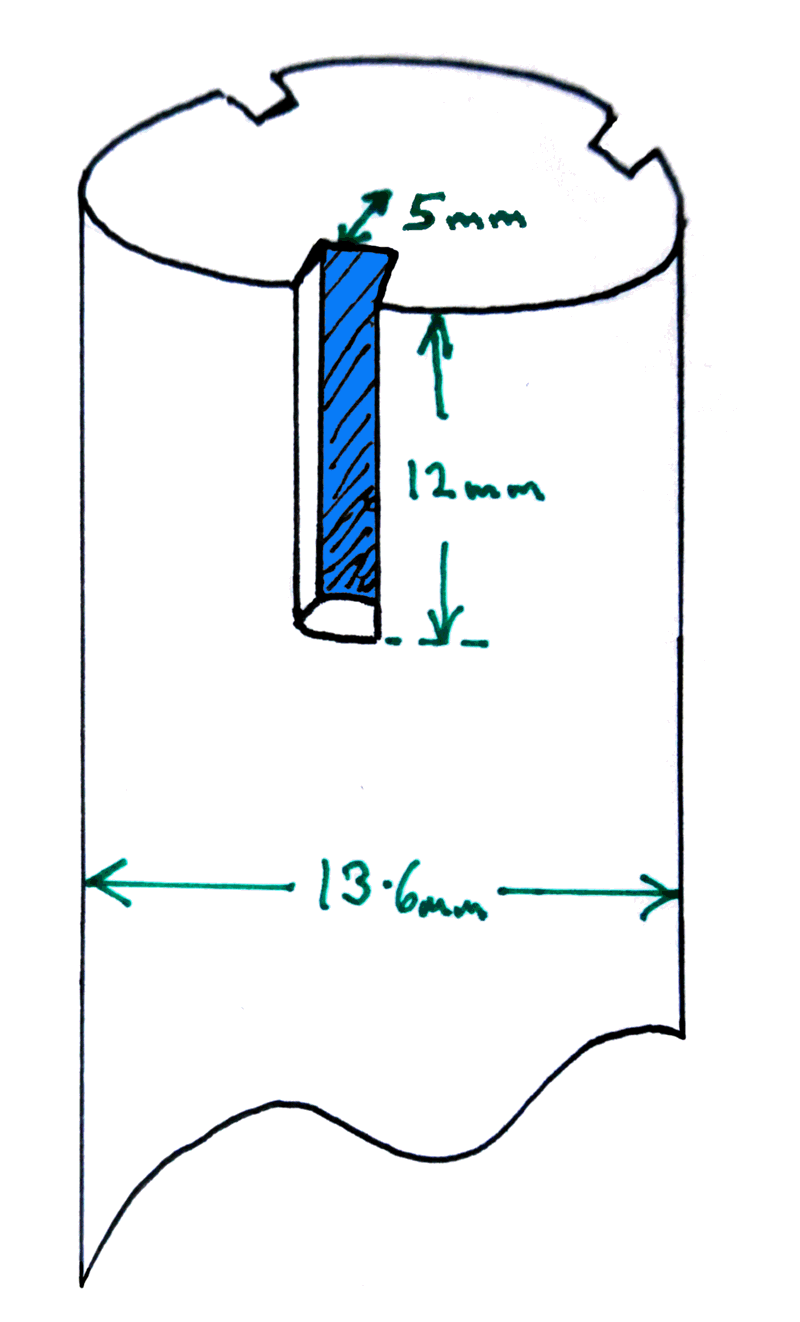
The sensors have sockets on their under side. To mount the sensor, you push the top of a pole into the socket. Some "fins" inside the socket prevent it from twisting on the top of its pole.
Do "slots for fins" first. Assign one pole to each sensor, i.e. don't treat them as interchangeable. Drill hole in post (not shown in diagrams) for "keep it on" screw/bolt at end of "make post" process. (I found one of my sensor's socket-for-post was slightly deeper than the other's.)
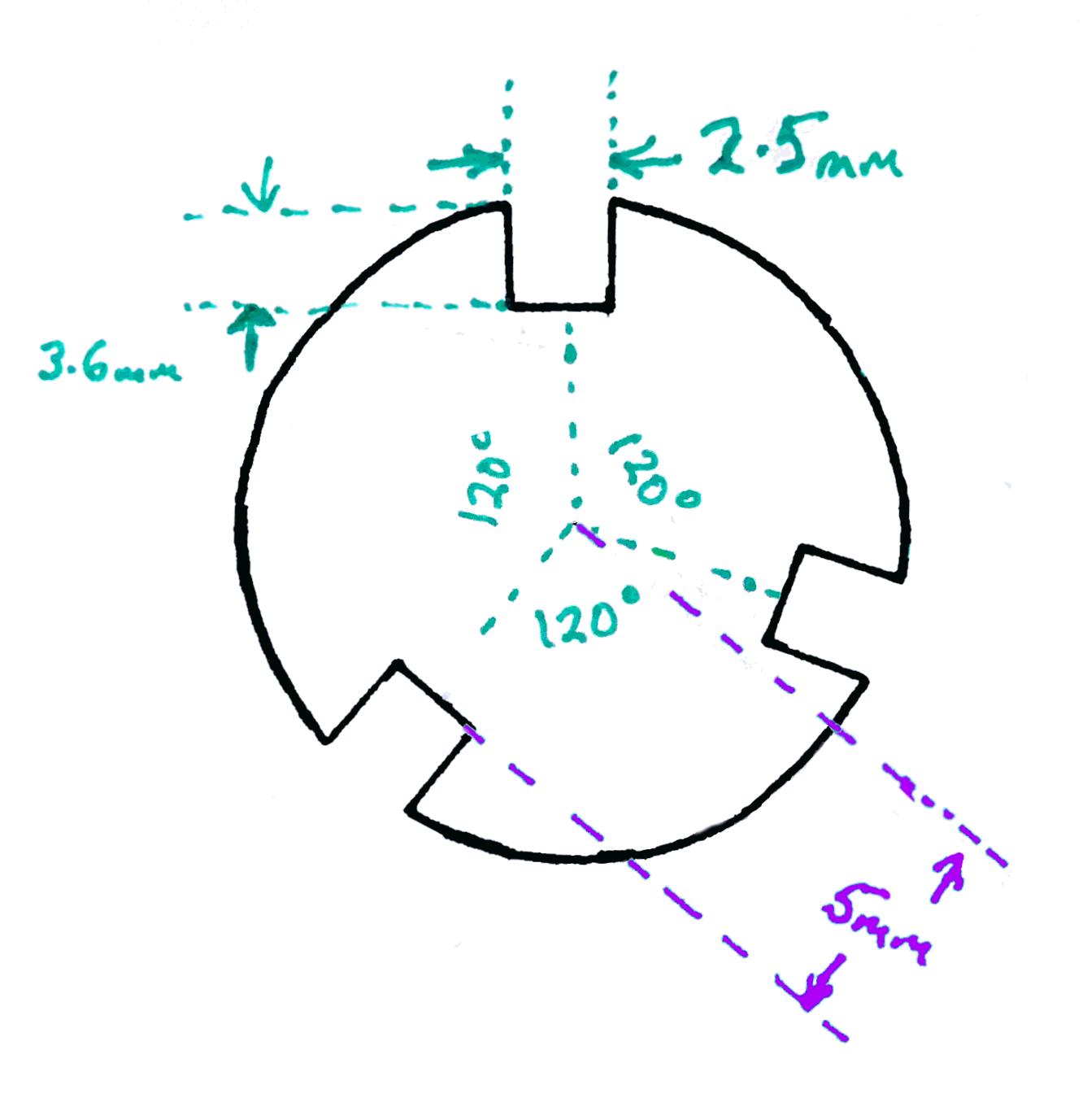
Think hard about how you want to mount the sensors... both "what will the posts be?" and "what will support the posts?". And then double whatever you thought would be "good enough". All of it will be outside for a long time, we hope. In "all winds and weathers", as they say. The day of the highest wind is the day you really don't want it to fail. Spend extra time now making it all very robust. You'll want to mount it high. You don't want to be going back to re-mount it.
Once you have the sensors mounted on "posts", you need something to attach the posts to. If you are going to take advantage of the clever "daisy-chaining" opportunity created by the designers of the sensors, make sure that you mount the sensors close enough to one another.
One answer to mounting the "on-posts" sensors is to use pipe of a suitable diameter to establish "sockets" the posts can slot into.
If you are making your own poles for mounting the sensors, I hope the diagrams here will make your task easier. I won't promise that the figures are right to the nearest 1%, but the may make a good starting point for you.
Water. Can't live without it. Living with it can be a pain, too. Rainfall measuring gets messy, and the equipment suffers.
I believe that the rainfall measuring device included in the "sensor sets" is one I met years ago as a stand-alone device. It is said to be of the "tipping bucket" type, which is "the way to go", as far as I'm concerned. Easy to interface to electronics. Reliable.
The "mouth" of the collector was, however, quite small... 15cm x 6cm. It "worked"... but I've been happier with a larger one (see rainfall sensors page) that I bought later. The larger one was quite expensive... but not on a "per year" basis over the time it has been working faithfully for me.
![]() Page tested for compliance with INDUSTRY (not MS-only) standards, using the free, publicly accessible validator at validator.w3.org
Page tested for compliance with INDUSTRY (not MS-only) standards, using the free, publicly accessible validator at validator.w3.org
....... P a g e . . . E n d s .....